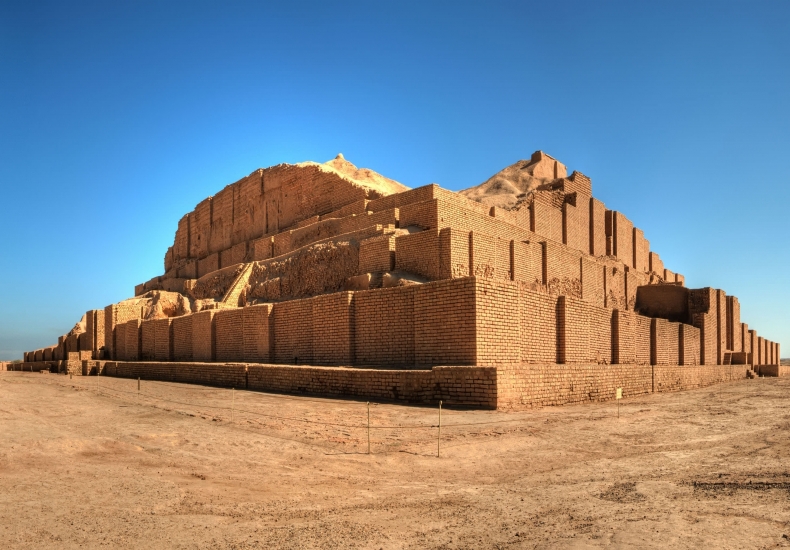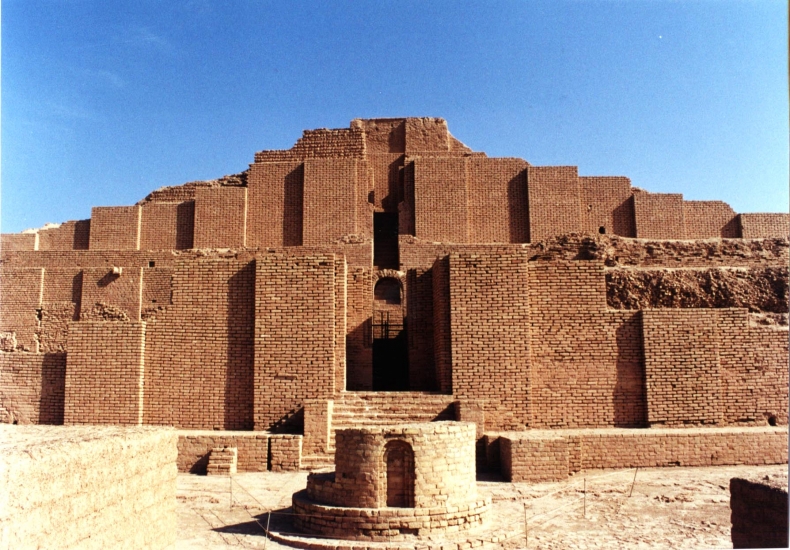Throughout human history, from the very first initial civilizations, people of various nations believed in and worshiped a God, a symbol, an element or a monument. The beautiful fact about this was that, in ancient history, a group of people wholeheartedly believed in one single God, element, or symbol. They would take their beliefs seriously, and their rituals were inseparable from their lives.
One of the first ancient pre-Iranian civilizations were Elam, dating back to 3000 BC and was centred in the far west and southwest of what in now modern-day Iran, stretching from the lowlands of what is now Khuzistan and Ilam Province as well as a small part of southern Iraq. Elam also known as Susiana, was one of the early urbanizations during the Chalcolithic period. During old Elamite period, Elam consisted of kingdoms on Iranian plateau and from mid-2nd millennium BC, it was centred in Susa.
Elamite is considered a language isolate and the current Persian language is unrelated to the language used in Elam. In geographical terms, Susiana refers to the Iranian province of Khuzestan and river Karun.
As a city of first civilisation and various Persian empires, Achaemenid, Seleucid, Parthian and Sassanid empires, Susa is of particularly high importance. So it is essential to start to acknowledge the significance of this city, their people and beliefs, architecture and temples.
In this article we’re focusing mainly on Susa’s Choqa Zanbil, which was simultaneously registered as UNESCO’s national heritage site in 1979, with Takht-e-Jamshid and Naqsh-e-Jahan square.
The ancient city of Susa, has an area of 5.6 km2 and is located 115 km from northwest of Ahwaz city, in Khuzestan province. Susa is 87 m above sea level, located in lower Zagros Mountains, 250km east of Tigris River. The modern Iranian town of Shush is located at the site of ancient Susa. The ground distance between Tehran and Shush (modern town of Shush), is 766 km and the air distance is 479 km. Choqa Zanbil is one of the few existent Ziggurats and is 45 km to the west of Shush town, near “Haft Tappeh” (Seven mounds) ancient site, 35 kilometers from Shushtar town, and is accessible via Shush-Ahwaz road.
Duruntash is an ancient pyramid with three concentric enclosure walls in the south west of Iran, which was built by an Elamite King, “Untash Napirisha”. At the centre of this city, stands a Ziggurat temple.
Castles and houses were located in the area between the first and second enclosure wall. In this part of the city, three palaces were built on the eastern corner and in the vicinity of king’s gate. Between the second and third enclosure walls, was a sacred neighborhood for the Gods of the Temples and finally inside the 3rd enclosure wall, belonged to the temple of Ziggurat.
Choqa Zanbil Ziggurat is the ancient name of this site, and in terms of terminology it is a combination of two words “Chogha” means mound or hill in local dialect, and “Zanbil” means “Basket”. The Elamite name of this structure is Ziggurat Duruntash, as it stands in the centre of the ancient city of Duruntash. Duruntash consists of two parts, “Dur” and “Untash” (the name of the King), which means the “Fortress(Castle) of Untash”.
Choqa Zanbil is a Ziggurat, which was built by king “Untash Napirisha” in 13th century BC. For the purpose of protecting Inshushinak, one of the major Gods of Elamites the protector deity of Susa, a 5 story building was made from brick. This structure is in the ancient city of “Duruntash”.
The discovery story of Choqa Zanbil Ziggurat, starts from when “Jacques de Morgan”, a French mining engineer, were informed of the presence of Oil mines, in this area. 50 years later after the World War I, the engineers found a brick writing at the site they were working at. Roman Girshman, were entrusted the excavation responsibilities, by the museum of Louvre. With the onset of preliminary excavations and research, the efforts for finding the source of the brick begun. After eleven years, the excavations finally led to discovering Choqa Zanbil Ziggurat, which was buried under piles of soil. Although discovering this structure, shed more light on the history of Persia and added to the knowledge about this ancient land, but after 50 years from discovering Choqa Zanbil, leaving it defenceless towards the erosive elements of nature, has done some serious damages to this mud-adobe structure.
Choqa Zanbil is square shaped, with 105*105 m2 area and 52 -meters height and a total of 1625-meters barrier around it. The floors have been creatively built above each other. In a way that the foundation of each floor, is set on the ground and not on the previous floor. Second floor were accessible via stairways on the north east and west side of the structure.
Four main stairways were embedded on each side of Choqa Zanbil Ziggurat, which would lead to the 1st level. The stairway on the southwest of the building were intended for climbing up to upper floors. On top of each stairway, big semilunar arcs can be seen. Only the first, second and part of the 3rd floor, about 23 m height, remains of this structure, and there’s no sign of 4th and 5th floors.
Big rooms and areas were built around Chogha Zanbil for the purpose of holding rituals and religious ceremonies and the stairs of the Ziggurat, would take people to the God sitting at the highest point. Elamites believed that their God, is watching over them from atop. Accordingly, the symbol of their God, “Inshushinak” were placed on the last level of this structure.
This Ziggurat were dedicated to great gods of Elamites, “Inshushinak” and “Napirisha”. Other temples were also built for other Gods, in Choqa Zanbil”:
- Nusku (God of Fire)
- Pinikir (Grandmother of the Gods)
- Adad (God of Air)
- Nin-Ali (Wife of Adad)
- Shimut (God of Elam)
- Manzat (Wife of Shimut)
- Nepratep (Goddesses of Prosperity)
- Ruhuratir
- Hishmitik (Wife of Ruhuratir)
- Gal (Great God of Elam)
Choqa Zanbil Ziggurat is one of the first ancient monuments in Iran that found its way to the list of UNESCO’s natural heritage sites.
Chogha Zanbil was equipped with water refinery facility, which followed the “Communicating Vessels” rule of Physics. Roman Girshman, excavator of Choqa Zanbil Ziggurat believes that, the water supply for this water refinery facility were provided from “Karkheh” river. This was despite the fact that the river was located 3 kilometres from the Ziggurat. The fact that they didn’t use the water of “Dez” river as a water supply was a significant height difference.
On the west and east sides of Ziggurat, platforms have been found. These platforms are about 1-metre high and has a diameter of 120 cm. Cultural Heritage organization experts believe that these platforms were utilized as places for sacrifice.
Sundial was first utilized by Elamites for sighting sunsets, sunrises and the motion of the sun. On two sides of the Ziggurat, two brick structures, resemble sundials, and it seems that a group of three columns formed an observatory, or a calendar, for measuring and counting the days and years, which helped them recognize the first and middle days of every year.
Evidences indicate that before the completion of the ancient city of Duruntashi and the Ziggurat, they were taken over and destroyed by the Assyrian king, Ashurbanipal. A tablet has been found on site of Chogha Zanbil, which says:
“Susa, the great holy city, abode of their gods, seat of their mysteries, I conquered. I entered its palaces, I opened their treasuries where silver and gold, goods and wealth were amassed. . . .I destroyed the Ziggurat of Susa. I smashed its shining copper horns. I reduced the temples of Elam to naught; their gods and goddesses I scattered to the winds. The tombs of their ancient and recent kings I devastated, I exposed to the sun, and I carried away their bones toward the land of Ashur. I devastated the provinces of Elam and, on their lands, I sowed salt.”
***A cuneiform inscription Untash Napirisha has also been found at the site:
“I, Untash Gal, carved golden bricks. I built this abode for the gods of Gal and Ishushinak, and dedicated this sacred place. May it be accepted by the gods of Gal and Ishushinak.”
The precincts of Chogha Zanbil are covered with stones and on some of them, there are what seem to be the footprints of children. Another interesting thing about this structure is that, waterways have been embedded in this building in order to protect it from heavy rains and flooding. Various cuneiform inscriptions around the walls of Ziggurat, metal, glazed objects, decorative objects, practical materials, potteries, footprints and seals, were discovered during the excavations.
A memorial tablet of Untash Napirisha is one of the antiquities found at this site. On this inscription you can see a figure of a woman with a fish tail and snakes in her hands. This tablet belongs to middle Elamite era, between 1300 to 1340 BCE. This memorial was brought to Choqa Zanbil during 12th century BCE and it is now in Louvre museum.
Adobe is the dominant material used in building Choqa Zanbil. Bricks were used to prevent the erosion of the easy-erosive adobe. They had utilized glazed bricks, natural tar, plaster coatings, and glass decorations for building this structure. During the excavation potteries of male cows who guarded the Ziggurat gates, have been unearthed.
Near some of the temples, pottery furnaces have also been discovered.
Given that the central and southern parts of Iran are hot and humid in the first 7 months of year (From March to October), the best time for travelling to this part of Iran, is during winter, or perhaps from November till the end of Persian year. So if you’re planning to see this part of Iran during your next travel to Iran, you can choose to schedule you travel from October and forward.
Choqa Zanbil is located between the cities of Shush and Shushtar, in Khuzestan province. You can take taxis from either of the cities to Chogha Zanbil. But first you need to get to Khuzistan Province. Due to the fact that, the the ground distance between Tehran and Shush (modern town of Shush), is 766 km and the air distance is 479 km, you can either take a train from Tehran straight to Shush, or you can take a one-and-a-half-hour flight to Ahwaz. Transportation in Ahwaz is easy, as it has Taxis and Buses. From Ahwaz, it takes about 2 hours to get to Choqa Zanbil. If you’re staying in Shush city, it will take you about 30 minutes to get to the Ziggurat. Before leaving your starting point of travel, wether it’s in Tehran or somewhere else in Iran, make your hotel reservations beforehand, either in the city of Ahwaz or in Shush or Shushtar.
We'll Make your arrangements and reservations, as Iran Negin Travel experts in Iran tourism market we can also provide you with good information on reliable tours for your desired destination.
Choqa Zanbil is an incredible elamite complex in Khuzestan Province. Iran Negin Travel team recommend you to travel to Iran and visit this Unesco World Heritage Site near Ahvaz. Thorugh our Iran tour packages you can visit every single important sights in Iran. Our Iran tour packages are made to plan your trip to Iran with unique services. We can make your trip to Iran a wonderful trip.
Contact us and get the best offers for Iran tours packages and visit Iran.


07:00 - 18:00
200.000 IRR